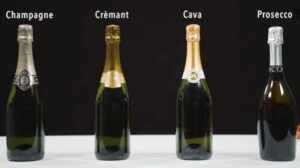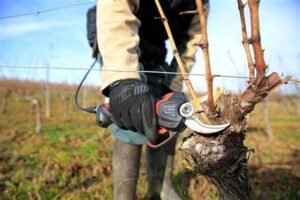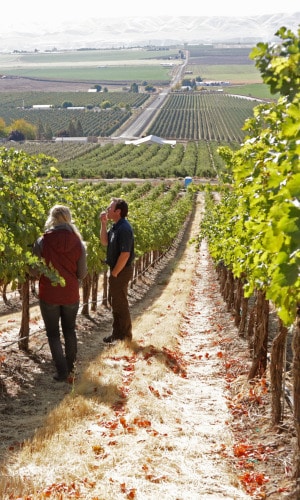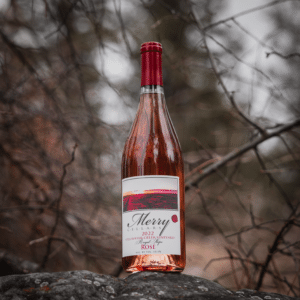TYPES OF SPARKLES (And is there a difference between sparkling wine and Champagne, anyway?)
It’s the epitome of celebration, the exclamation point on a toast, the most fun you can have in a glass—sparkling wine as a concept supersedes its value as a beverage. Its almost mythic status in the world of wine can make it intimidating to approach but once the curtain is pulled back it’s just as easy to enjoy as any other glass of wine. From the forced-carbonated bottles in the grocery store to the eye-wateringly expensive vintage champagnes revered the world over, let’s talk definitions and differences.
The most familiar type of bubbly is champagne, a word that for centuries has been synonymous with the category itself. Champagne is also a famous example of a geographically designated product—a wine can only be labeled as champagne if it comes from the official Champagne region of northern France and is made in accordance with the regulations set in place by the CIVC* (Interprofessional Committee for Champagne Wine).

In addition to the geographical constraints, champagne must be produced from an approved list of seven grape varietals: Pinot Noir and Pinot Muenier make up about 94 percent of production; about 5 percent comes from Chardonnay; and the remainder is Pinot Gris, Pinot Blanc, Petit Meslier, and Arbane. New to the allowed mix is Voltis, a fungus-resistant variety, and which has only been allowed in the region since 2021.
Other sparkling French wines you’ve seen might be Crémant from Bordeaux. Of the six red varieties* found in these wines, Cabernet Sauvignon and Merlot appear most commonly in rosés; and for sparkling whites, all three traditional grapes are used.
Prosecco is not to be forgotten in the wake of champagne and crémant. Traditionally from northeast Italy in the Veneto region and made from Prosecco grapes, this type of sparkling has also been widely made in Australia for decades. In an effort to regain the regional association between Prosecco and Veneto, the Italians succeeded in pushing to rename the grape to Glera, and it was changed in 2009.
The Spanish make Cava, named for the caves (cavas) in which the wine was laid down to age. (Prior to 1970 they called it simply champaña, but once Champagne cracked down on the naming rules of their local product the Spanish had to pick a new word.) The acceptable varieties for cava production are traditionally Macabeo, Parellada, and Xarel-lo grapes; and now also Chardonnay and Pinot Noir are allowed.

Other winemaking regions of the world produce plenty of sparkling wine using all kinds of varieties and methods, but they aren’t restricted in the same way as those previously mentioned. Sparkling red wines, usually Shiraz, are found in Australia; Gewürztraminer and Riesling in Germany; and of course, sparkling wines made worldwide in exactly the same style with the same varieties as some of these geographically specific types are not allowed to use the local names.
SETTING THE STAGE TO MAKE SPARKLING WINE
Before the grapes even get to the cellar a vineyard can choose to implement specialized techniques to beget fruit better suited to the end goal. For sparkling wine fruit, this can look like lower intervention: leaving more buds during winter pruning leads to a big canopy with lots of clusters, and acid stays high during ripening. Harvest happens earlier compared to fruit destined for table wines, when the grapes are at a lower sugar and pH level.

Once the fruit is picked, production happens as normal to produce a still table wine:
- Gentle pressing of whole clusters for lower level of phenolic extraction.
- Primary ferment like normal: in stainless steel, neutral oak, plastic, concrete, etc.
- Malolactic fermentation according to winemaker preference (inoculation with bacteria that transforms harsher malic acid into smoother lactic acid; affects mouthfeel and aids in microbial stability).
- Cold stabilization to drop out tartrates.
- Clarification and filtration to finish the still wine.
METHODS OF CARBONATION
Now we have wine, but how do we make it sparkle? In almost all cases a second ferment is forced in order to produce carbon dioxide, which then stays trapped in the wine and leads to the bubbly experience we have come to love.
The most famous technique for this secondary ferment is the traditional method (also referred to as méthode traditionnelle or Champagne Method/Méthode Champenoise). The first step is tirage, when the wine is bottled and the liqueur de tirage is added: a mixture of sugar, yeast, nutrients, and a riddling agent. The bottle is stoppered with a plastic cylindrical bidule and sealed with either a crown cap or cork closure. The sugar is converted by the yeast (this is the second ferment), which is how CO2 becomes part of the situation. There is also a slight bump in ethanol, about 1.2 to 1.4 percent. The nutrients in the liqueur promote yeast health and longevity, so the ferment has a stronger chance of going to completion and not becoming stuck. The riddling agent will help compact the yeast in the neck of the bottle after ferment is over; and the bidule is a tool for easier disgorgement. The crown cap or cork holds it all together.
The entirety of secondary fermentation happens with the bottles lying horizontally on their sides so the liqueur is as spread out as possible, and not compacted in the bottom of the bottle where it wouldn’t have as much space for integration. This is also the position for the bottles while they age sur lie (on the lees), because the dead yeast cells (the lees) having contact with the wine is what gives many sparklings their characteristic toasty flavors. Some wines have specific requirements for aging: non-vintage champagne must be aged for 15 months sur lie and 36 months for vintage; cava ages for 9 months, and 30 months for Gran Reserva.

When the ferment and aging are complete, the bottles are staged for riddling. This can be done manually by hand by a remeur (bottle turner) in a pupitre (board with holes to hold the bottles in position), or in an automated system on a gyropalette. Essentially, the bottles are angled downward (sur pointe) so all the sediment will settle in the neck of the bottle against the bidule. The remeur will turn each bottle several times a day to encourage the displacement of this sediment, and the entire process can take as long as six weeks. A gyropalette can achieve the same result in about one week.
Once the now-sparkling wine is clarified in bottle as a result of the riddling, it’s time for disgorgement. The bottles are cooled and the necks are frozen in glycol. They are unsealed and the bidule and yeast plug are removed with minimal loss of wine and CO2. Any final adds of sugar or other elements are made to the wine during the dosage stage (similar to during tirage, this mixture is called the liqueur de dosage). The final bottle closure is installed, usually a cork and wire cage (muselet) but sometimes crown caps are used for this. The bottle pressure achieved by the traditional method is about 5-7 atmospheres (75-100 psi).
The tank method of making sparkling wine, also called the charmat method, is a newer technique than traditional but still has been applied since the early 1900s thanks to technological advancement which made pressurized vessels safer and more accessible to use in the winery. Such familiar wines as prosecco and lambrusco are made this way. Once the base wine has been prepared, the liqueur de tirage (sans a riddling agent) is added to wine in tank rather than in bottle. Upon completion of secondary fermentation, the wine is filtered under constant pressure using specialized equipment rated for pressurization. Liqueur de dosage is added and the final composition is filtered together one last time before bottling. The final bottle pressure of charmat wines is about 2-4 atm (30-60 psi).

The quickest and cheapest method of making sparkling wine is by forced carbonation, also called the industrial method. Completed still wine does not undergo a secondary fermentation to achieve sparkling status but is instead filtered into a pressure-safe tank and carbonated with the direct addition of CO2 gas. The wine is usually chilled way down in the tank for this step because gas is more soluble into liquid at lower temperatures, and so is easier to force into the wine at a higher concentration. As the carbonation is artificial in this method, the final bottle or can pressure of industrial wines can be fine tuned to whatever the winemaking team desires.
A few lesser-known techniques for sparkling production are transfer, ancestral, and continuous. The transfer method is nearly the same as traditional method but after secondary fermentation the bottles don’t go through riddling and disgorgement but are emptied into a pressure tank and filtered from there. This is most commonly done for off-size formats, like splits and double magnums.
The ancestral method uses extremely low temperature and filtration to halt the primary ferment part way to retain sugar and yeast. The wine is bottled without filtration and closed with crown caps, and no liqueur is added. Secondary ferment takes place in the bottle over time as the wine goes to dryness and CO2 is preserved. The bottles are placed on their bases, rather than upside down, and should not be unduly agitated so as not to disrupt the sediment in the bottom. This is almost certainly the oldest form of sparkling production, hence “ancestral”, and is how pétillant naturel wines are made.
The continuous method (aka the Russian method as it was developed in the USSR) is probably the least common and is a derivative of charmat. This production technique sees wine pumped from tank to pressurized tank with additions made at each step: tirage in the first tank; then addition of yeast enrichments such as oak or other wood upon subsequent transfers to adjust flavor profile and mouthfeel; and lastly clarification by flotation (on account of the wood addition, to which yeast attaches and floats on top of the wine) before final bottling.
POP THE CORK AND CHEERS!
As they say, anything can be a wine glass if it holds still long enough (does anyone say that?), but a few styles of glassware were developed especially for sparkling wine. The coupe is the most traditional and initially was the most widely-used. First recorded in 1734 in a Jean-François de Troy painting, this stemmed glass is shallow and wide, like a rounded martini. While it’s beautiful and still used for cocktails today, it makes a poor vessel for sparkling as the shape of the bowl allows for carbonation to escape freely and doesn’t capture aromatics well.
In 1831 the trumpet blared onto the scene. Stemless and with a rim bent outward in the shape of its namesake horn, this Belgian glass warms quickly from the hand’s heat and allows for rapid escape of carbonation.
More recently the champagne flute was popular in the 1950s. It is tall and narrow with a low point or bead of glass in the center of the bowl to concentrate bubbles and help them float to the top of the wine from the middle, not just along the sides of the glass.
The tulip is thought by many to be the best way to enjoy sparkling. It is like a cross between a standard wine glass and a flute: narrow at the top with an inward-curved rim to preserve bubbles, wide in the middle to allow for more aromatic expression, and sharply narrow to the base to preserve carbonation.

The second most important part of sparkling wine, after drinking it, is how to find the ones you like. Here are a few vocabulary words to help you understand the labels and to give you benchmarks in finding your favorites:
Vintage and non-vintage: in wine the word “vintage” means the year grapes were harvested and made into wine. A vintage champagne is one made entirely from the wine grown in one single year, versus a non-vintage is one whose base wine is a blend of multiple years.
Bubbles and pressure: there are a few categories of how carbonated a wine can be. A beady, or table, wine has less than 1 atmosphere pressure in bottle. Semi-sparkling, such as frizzante, spritzig, and pétillant have 1-2.5 atm. Sparkling means 3 or more atm. These are the more typical wines we’ve been talking about: cava, champagne, and crémant, as well as sekt, spumante, etc.
In wine, sweet and dry are chemistry words more than taste or flavor descriptors. There are names for levels of sweetness that correspond to how much residual sugar is in the wine:
- Brut Nature has 0-3 grams per liter of residual sugar
- Extra Brut 0-6 g/L
- Brut 0-12 g/L
- Extra Dry 12-17 g/L
- Secco 17-32 g/L
- Demi-Sec 32-50 g/L
- Doux 50+ g/L
RAISE A GLASS
Sparkling wines have been developed and enjoyed for centuries, and have long been representative of luxury, celebration, and good fortune. It seems no high-end art or fashion event is complete without a glass of champagne, no podium truly enjoyed without a shaken shower, and no ship successfully launched without a bottle broken upon its bow.
My favorite cultural moment with sparkling wine is one I learned about recently when I went on a hot air balloon ride for the first time. At the end, our guide (I find it delightful that a hot air balloon operator is called a balloonist) told us about the tradition of making a champagne toast in recognition of a safe flight and return to ground.

The story goes that way back during the development of balloons, the usual way for a touchdown to resolve was in literal burning, as fuels were yet unstable and many a kink needed to be worked out with the whole business. In an attempt to assuage the fury of the farmer whose field was inevitably scarred by such an event, balloonists would bring champagne as a bribe gift to the landholder. Once the fiery technology improved and balloons were able to land rather than crash, the champagne was used more in celebration than apology.
Another version of the legend says that local villagers who had never seen nor heard of the massive people-carrying balloons would become afraid and attack the strangeness with pitchforks and sundries, so the champagne was given out to soothe everyone’s worries about the flying craft. Likely the truth is a mix of the two! As now the balloons are pretty reliable and everyone knows what to expect, the wine is enjoyed by excited participants rather than furious bystanders, and The Balloonist’s Prayer is given as a toast in thanks to the success of the flight. It brings a wee tear to my eye whenever I read it:
The winds have welcomed us with softness.
The sun has blessed us with its warm hands.
We have flown so high and so well that God has joined us in laughter.
And set us gently back into the arms of Mother Earth.
Whether you’re celebrating a momentous life event or just enjoying the weekend, remember that sometimes champagne itself is the occasion.
Cheers, friends!
—Maureen
*Comité Interprofessionnel du Vin de Champagne (in English: Interprofessional Committee for Champagne Wine), established in 1941 is a conglomerate of all the aspects of the French industry that deals with Champagne and its wines.





